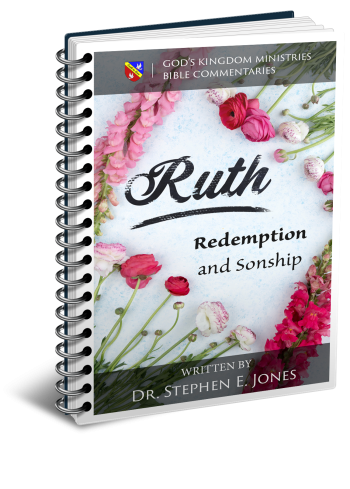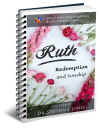Latest Posts
View the latest posts in an easy-to-read list format, with filtering options.

The book of Ruth is the Bible's primary illustration of the law of sonship found in Deuteronomy 25. The story also illustrates the principles of New Covenant marriage as God set forth from the beginning. In addition, it is a natural sequel to the last five chapters of the book of Judges, showing the moral contrast between the home towns of Saul and David as a way of explaining the failure of Saul and the success of David.
Category - Bible Commentaries

As we have seen, it is important to fulfill the law of God in accordance with the covenant that essentially defines the law’s implementation. The law of sonship must be implemented in accordance with the inheritance that we are expecting, whether that is a piece of real estate or the glorified body.
In similar fashion, while the Old Covenant mandated daily animal sacrifices, the New Covenant mandates sacrificing just one time the Lamb of God and thereafter placing our faith in that Sacrifice.
Now that the New Covenant has been instituted, it is no longer proper to revert back to a failed covenant that “is becoming obsolete and … is ready to disappear” (Heb. 8:13).
Recognizing this change does not put away the law. It recognizes that the commandments are now promises and that God Himself is now responsible to write the law in our hearts until all things are put under the feet of Christ. For this to be accomplished, certain forms had to be changed, as defined primarily by the book of Hebrews.
Yet the law’s principles remain intact. What changed was who was responsible to keep the oath—man or God.
After Ruth spent the night with Boaz in the barley field, he told someone—probably some of his servants—not to tell anyone that she had been there. Ruth 3:14 says,
14 So she lay at his feet until morning and rose before one could recognize another; and he said, “Let it not be known that the woman came to the threshing floor.”
Who did he instruct to keep this secret? It implies that there were others who had remained in the field that night and that they discovered in the early morning that Ruth had been there as well. Although Boaz had committed no sin, he wanted to avoid small-town gossip and suspicion. At the same time, this incident proved to Ruth that Boaz had moral integrity and could be trusted.
Ruth 3:15 continues,
15 Again he said, “Give me the cloak that is on you and hold it.” So she held it, and he measured six measures of barley and laid it on her. Then she went into the city.
We are not told the size of each measure, but no doubt this was six omers of barley, for she could hardly carry six ephahs of barley. Earlier, she had worked all day to obtain one ephah (Ruth 2:17), which was a considerable amount in itself. So we must assume that Boaz gave her six omers, which she could have carried in her outer cloak without any problem.
The biblical text above reads, “he measured six barley and laid it on her.” We are left to assume that this means six omers of barley. She had already gleaned ten omers the previous day, a number associated with divine order and the divine law. But now she received six more for a total of sixteen omers of barley.
Sixteen is the biblical number of LOVE, suggesting that Boaz’s relationship had progressed accordingly.
By comparing this with Jacob’s marriage to Leah and Rachel, we may gain a better prophetic understanding of the progressive relationship between Boaz and Ruth. Both Leah and Rachel were lawfully married to Jacob, but their relationship was different. Leah had a legal relationship with Jacob; Jacob had obligations to fulfill. But Rachel had a love relationship with Jacob, and that relationship produced the heir to the birthright (Joseph).
In the case of Boaz, we find him first acting with lawful integrity (ten omers) and then progressing into actual love (sixteen). When he gave her another six omers of barley for a total of sixteen, it suggested symbolically that he fell in love with her. This, then, set the background for the court case the following day in chapter 4.
Ruth 3:16, 17 says,
16 And when she came to her mother-in-law, she said, “How did it go, my daughter?” And she told her all that the man had done for her. 17 And she said, “These six measures of barley he gave to me, for he said, ‘Do not go to your mother-in-law empty-handed’.”
Whereas Ruth, by the law of gleanings, had obtained an ephah of barley, the gift of six omers now suggests a progression to the law of first-fruits. On the surface, Boaz was extending kindness by his usual generosity, not only to Ruth but also to Naomi. But from a prophetic standpoint, his words (quoted by Ruth) bring us back to the law of first-fruits manifested in the feasts of the Lord. We read in Deut. 16:16, 17,
16 Three times in a year all your males shall appear before the Lord your God in the place which He chooses, at the Feast of Unleavened Bread and at the Feast of Weeks and at the Feast of Booths, and they shall not appear before the Lord empty-handed. 17 Every man shall give as he is able, according to the blessing of the Lord your God which He has given you.
There were three different first-fruits offerings, one for each of the three main feasts wherein the people were to appear before God at the place where He had chosen to place His name. In the case of Boaz and Ruth, we know that they were already harvesting their barley, so this took place after the first-fruits of barley had been offered to God. Boaz prophetically extended this offering on a secondary level, not wanting Ruth to return to Naomi “empty-handed.”
Likewise, in accordance with verse 17 above, Boaz gave “according to the blessing of the Lord your God which He has given you.” Boaz was giving according to the blessing that God had given him—the blessing of Ruth herself and of her love.
The story thus suggests that Ruth represented the barley company, those who have a genuine love relationship with Christ and not merely a lawful relationship with Him based on obligation. The first-fruits of barley were represented primarily by Christ Himself, our Head, when He ascended to be presented to the Father on the day of His resurrection. To complete this offering, the Body of Christ must also be raised from the dead, so that the New Creation Man (both Head and Body) may be presented complete and faultless to the Father.
This resurrection is prophesied by the Feast of Trumpets, and they will be united with the living overcomers when they are “changed” on the first day of Tabernacles. They will then be united with their Head in the midst (middle) of the Feast of Tabernacles (John 7:14), so that they may be presented to the Father on the eighth day of the feast.
As a woman, Ruth primarily represents the Bride of Christ, but secondarily, she also represents the sons of God. The same company are pictured in both ways biblically, depending on which relationship is being portrayed in any given moment.
Ruth 3:18 concludes,
18 Then she [Naomi] said, “Wait, my daughter, until you know how the matter turns out; for the man will not rest until he has settled it today.”
She knew that Boaz was in love with Ruth and that he would overcome the legal obstacle that threatened to prevent him from marrying Ruth. She knew that the matter was now in the hands of Boaz and that he would pursue the matter to its ultimate conclusion.